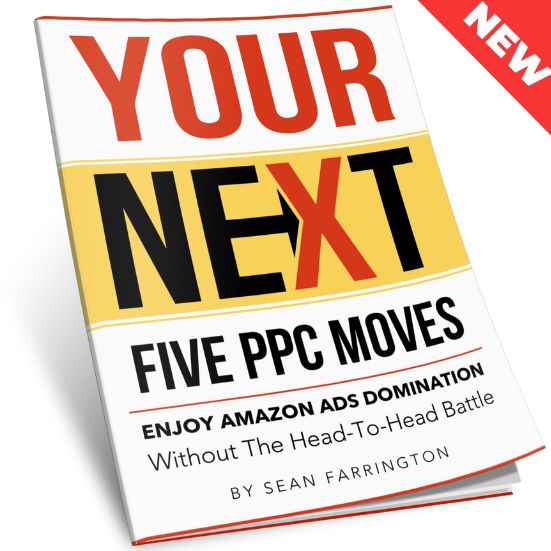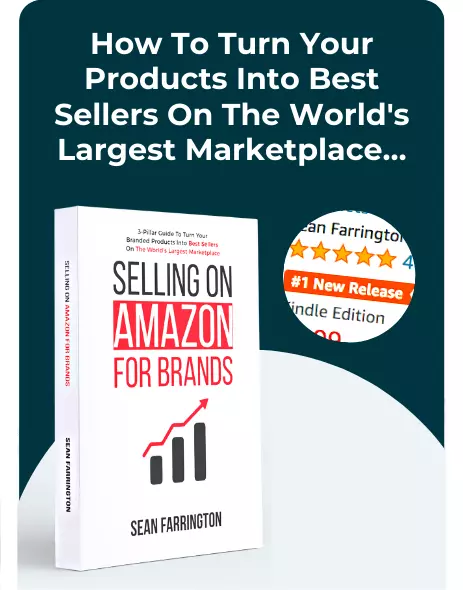Strategies of Amazon Company Marketing: Should Your Brand Use These 10 Moves?

If you are looking for the marketing strategies that Amazon used as Company, you are in the right place. This post will discuss those and show you how top sellers are using them to their own advantage.
When it comes to e-commerce, Amazon is a juggernaut of a sales channel for companies of all sizes. It’s no surprise then that many businesses look to emulate the marketing strategies that Amazon used to get to the top. And, unironically, they are using them on the platform that Amazon built.
Table of Contents
GET YOUR FREE COPY
(Limited Offer)
These are the shocking moves that your PPC specialist doesn’t know.
Now, you’ll be plotting super-profitable combinations that competitors never see coming.
This fast-paced PPC Playbook shows you everything, and it is all free. Why wait?
But should your brand be using these Amazon strategies?
It’s important to note that while there are numerous advantages associated with implementing certain marketing strategies — this doesn’t mean that you should completely overhaul everything about how you sell on Amazon at once.
Instead, take time to evaluate Amazon’s marketing strategy rollouts mentioned in this post. Decide which to try and then test to see if they may work for your situation before making any major changes. Doing so will help ensure that whatever actions you decide to take align with both short-term goals and long-term objectives.
Amazon Marketing Strategy 1: Leverage Influencer Marketing (Amazon Will Help)
Influencer marketing involves partnering with social media influencers to promote your products to their followers. Amazon stepped their influencer marketing game up in a big way by adding the Amazon Influencer Program.
The Amazon Influencer Program provides an opportunity for influencers to promote items from Amazon to their respective platforms. It is specifically geared toward influencers who operate on high-volume social media channels, rather than publishing or their own websites.
This program allows influencers to establish a custom storefront that offers products they endorse and encourages potential customers to purchase them. The process is comparable to a typical e-commerce site with one key difference: all purchases are made through Amazon instead of the influencer’s website. This expansion of reach further amplifies the power of influencer marketing, providing an expanded platform for brands and influencers alike.
The rise in popularity of the Amazon Influencer Program can help business increase brand awareness and drive sales. When choosing influencers to work with, it’s important to consider their audience demographics, engagement rates, and overall brand alignment.
Interesting data: According to a study by Influencer Marketing Hub, businesses earn an average of $5.20 for every $1 spent on influencer marketing.
For a deeper dive, check out our post from the influencer’s perspective on What Is An Amazon Influencer?
Amazon Marketing Strategy 2: Create Product Comparison A+ Content
Product comparison charts were created by Amazon to increase sales below the fold.
Below-the-fold sales happen when shoppers start scrolling below the marketing at the top of an Amazon sales page. There is a greater than 90% probability that when shoppers scroll the sale is lost.
Amazon created product comparison tables to recapture sales. They promote competitor products on your listing.
Now you can use this Amazon marketing strategy to your own advantage by creating product comparison tables for your products. These are a great way to guide your audience to more of your brand’s products such as cross-selling and/or differentiating between your product offerings.
Like this table from L’Oreal.
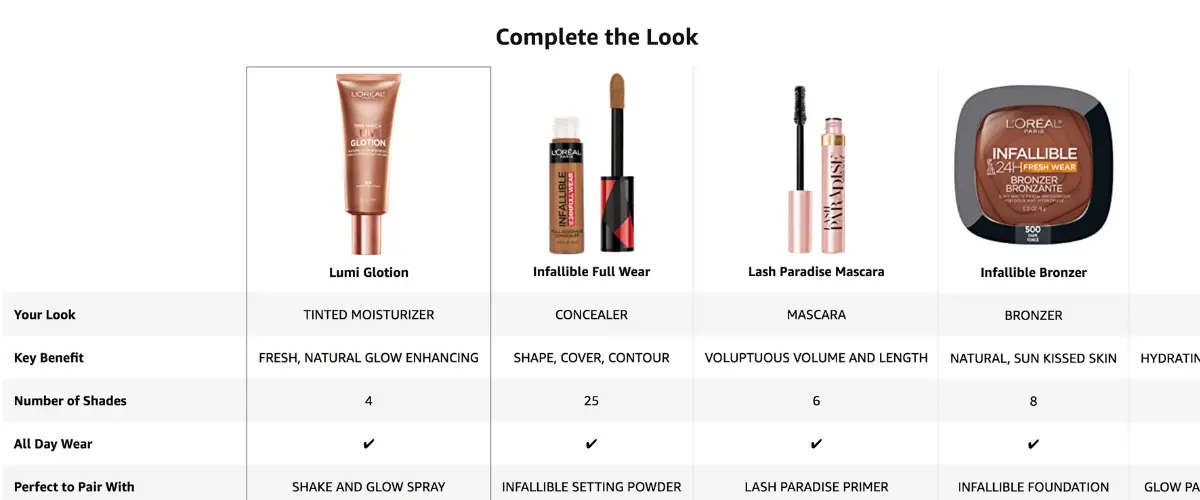
The team at Ecom Optimization likes to use these charts a bit differently. Unlike how many sellers use them, you can build a value ladder, moving shoppers toward higher-margin products and bundles. Simply add higher margin items from left to right.
By comparing similar products and highlighting their features and benefits, you can help your audience choose the product that is right for them and boost sales along the way.
To do a deep dive into the power of A+ content, check out Sean Farrington’s epic post: Amazon’s NEW Premium A+ Content and How to Get Started
Amazon Marketing Strategy 3: Create A Customer Reviews Strategy
In the mid-90s, the first online reviews started to become available. Initially, these reviews were restricted to sites like eBay, but later on, three primary sources emerged: Epinions, RateItAll, and Deja. They provided a total of 1,146,201 reviews about a range of products and entertainment sectors. Eventually, all of them were either bought out or taken over by larger businesses. Amazon saw the trend and jumped on board.
When Amazon first allowed customers to give feedback on products in 1995, many were skeptical that it would be successful. However, now it is considered a standard practice for retail websites to have customer reviews, and Amazon has seen over 5 million customers post tens of millions of reviews.
Today, customer reviews and feedback are critical to the success of your Amazon business. Positive reviews help increase sales because they provide social proof that your products have been tried and tested in real life with real people. Negative reviews, on the other hand, can damage your reputation and drive customers away.
This is why it’s critically important to actively monitor your reviews and respond to customer feedback in a timely and professional manner.
Consider using amazon software tools to stay on top of Amazon reviews. Apps such as Seller Labs are great tools for brands to maximize their presence on the platform. Not only can they help you monitor the star ratings and feedback of multiple products (including parent-child variations) but they also allow you to respond in an efficient manner.
This can be especially beneficial when dealing with negative reviews as responding quickly via your Amazon Brand Registry dashboard will show customers that their opinion matters and may even result in improved relationships between the brand and its consumers.
Additionally, staying in tune with what customers are saying about your products helps to identify areas where improvements can be made which could ultimately lead to increased sales.
Interesting data: According to a survey by BrightLocal, 79% trust online reviews as much as personal recommendations.
Why are Reviews Important for Amazon Sellers?
Reviews provide social proof to potential customers, letting them know that others have purchased and enjoyed your products – thus decreasing risk and lowering selling objections. Bottom line, positive reviews can help boost sales and drive more traffic to your listing.
Does Amazon’s Early Reviewer Program Work?
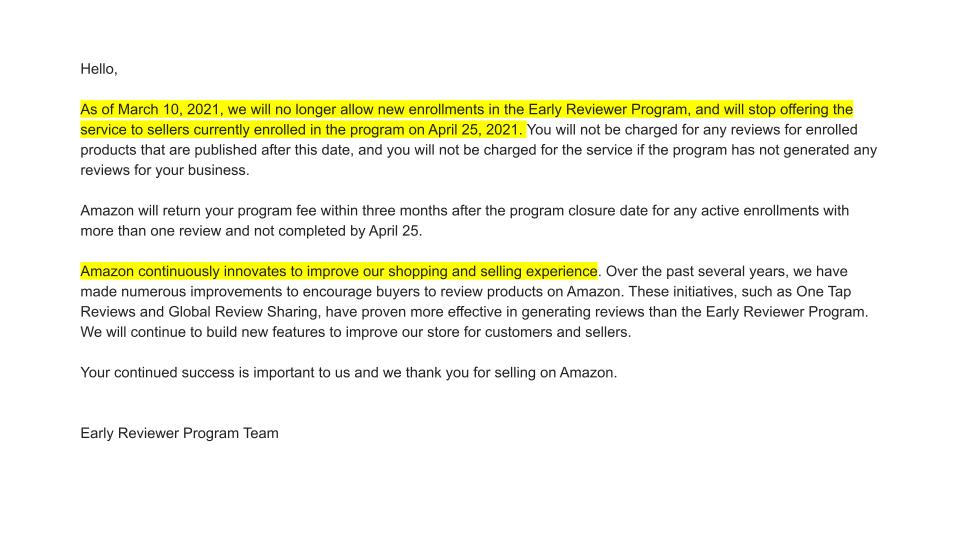
Amazon’s Early Reviewer Program is now defunct, however when it was operational it was a great asset to get sellers their first few reviews. The program incentivized customers to leave a review by offering them a small reward in exchange for their feedback. For example, if a customer purchases a new product from a seller enrolled in the Early Reviewer Program, they would be eligible to receive a $1-$3 Amazon gift card in exchange for leaving a review.
However, the catch is that early reviewers we’re known to be very picky (and many negative reviews were the result). Product tester sites then took over as the fastest way to get initial reviews.
Can You Buy Reviews For Amazon?
It is absolutely against Amazon’s terms of service to buy reviews. Doing so can result in severe consequences, including account suspension or termination.
Why?
Because buying reviews goes against Amazon’s commitment to providing honest and unbiased reviews for its customers. That said, buying reviews is a very common practice among Amazon sellers.
A Better Approach To Amazon Reviews
One of the most effective strategies Amazon sellers can use to encourage reviews is by incentivizing them. This can be done through product inserts that offer free products in exchange for honest product reviews.
Additionally, you can create your own private network of friends and family who will leave honest feedback on your products in exchange for a reward or incentive. By providing incentives, you encourage more people to leave reviews which will ultimately help increase visibility and make more sales for your brand.
If you would like to dive deeper into how to get reviews safely and effectively (with extra SEO to boot) check out this post: How To Take Control Of Your Amazon Reviews
Amazon Marketing Strategy 4: Use Third-Party Tools To Track Your Competitors
As early as 1997, Jeff Bezos had his eye on using data to improve digital marketing. Later, Amazon hired Artificial Intelligence expert Andreas Weigend as its first chief scientist, and he held weekly meetings discussing clickstream histories while having pizza and beer. Clickstreams are the digital trails Amazon follows to see where users come from, how they move through its pages, and where they go next.
Sellers have turned the tables on Amazon…
Today there are a variety of third-party tools available that can help you track your competitors to see what is working, and copy it. One popular option is Jungle Scout, which allows you to track your competitors’ sales volume, keyword rankings, and pricing strategies. This data can help you optimize the SEO of your listings, and improve ad targeting and pricing strategies to stay ahead of the competition.
Another useful tool is Sellics, which provides comprehensive analytics on your competitors’ sales data, product performance, and pricing strategies. Sellics also offers a range of other features, including inventory management and PPC advertising optimization, that can help you streamline your Amazon business operations.
Amazon Marketing Strategy 5: Improve Your Catalog Management
Since 1995, Amazon has changed the way we shop, read, use devices, and access cloud services.
Their success is no accident; they have consistently updated the way they layout their site (online catalog, if you will) to create better customer experiences. They have embraced taking risks and making mistakes. This effective marketing strategy has allowed them to remain innovative and influential.
Similarly, your product catalog is a crucial aspect of your sales strategy. By optimizing your product catalog, you can improve your product’s visibility and customer engagement on Amazon. Here are some tips to help you improve your catalog management:
Focus on product details: Provide accurate and detailed product information, including emotion-stirring product images, descriptions, and A+ content.
Optimize product variations: Use clear and concise variations to make it easy for shoppers to find the product they’re looking for.
Monitor product performance: Regularly monitor your product’s performance and make necessary changes to improve sales and profitability.
Amazon Marketing Strategy 6: Enhance Your Design
Amazon has been innovating site design ever since 1995. The goal was always for a better shopping experience. The improvements made to the design include a cleaner overall look, easier navigation between product pages and categories, detailed product descriptions with customer reviews and ratings, more personalized recommendations based on prior purchases as well as streamlined checkout processes.

The design makes users feel comfortable and decreases purchasing friction. Smart marketers take a cues from that approach and implement a CANI (Constant And Neverending Improvement) approach to their own design
Enhancing your design not only helps you stand out from the competition but also improves your brand equity on Amazon. Here are some tips to help you enhance your design:
Use high-quality images: Use high-resolution images to showcase your product and highlight its features.
Use attractive packaging: Design your product packaging to be visually appealing and stand out from competitors. Also, take into consideration the white-background requirement for Amazon main images, and consider packaging with high-contrast colors.
Focus on brand identity: Develop a brand identity that aligns with your target audience and use it consistently on all marketing material across the Amazon platform.
Amazon Marketing Strategy 7: Tell a Story
Amazon has cultivated its own unique brand story, positioning itself as the “Everything Store” and expressing this idea in the iconic A to Z arrow found in its logo.

The company’s founding by Jeff Bezos is also a key part of their narrative, emphasizing his vision for an online marketplace that would offer consumers any product or service they could think of.
This story has proven to be very successful in terms of marketing, creating strong customer loyalty and allowing Amazon to become one of the world’s biggest brands. By telling a compelling story about who it is and what it stands for, Amazon has been able to set itself apart from competitors and establish a powerful presence worldwide.
One of the most important aspects of building a successful brand on Amazon is developing a passionate brand story that you gently weave throughout all of your on-Amazon marketing.
Customers are more likely to be invested in a product that has a personal connection and a story behind it. This can help build brand loyalty and increase customer retention.
A great way to tell a story is with…
Amazon Marketing Strategy 8: User-generated content

Every item listed on the Amazon site has a star-rating based on user reviews and those reviews also provide feedback about the seller. Reviews serve as a way for buyers to gauge product quality without being able to physically see it or test it. At it’s core, Amazon reviews are some of the earliest User Generated content used for online marketing – in fact, many Amazon reviews now feature videos.
Sellers are currently using User-generated content (UGC) as a powerful tool for increasing brand visibility and building trust with customers.
Top companies that sell on Amazon us UGC to great effect in their marketing. Grabbing everything from video assets to testimonials and then leveraging them to show potential buyers what other people think about their products or services.
This kind of social proof is invaluable in driving conversions, as customers are more likely to purchase if they know that others have had positive experiences with the product.
Furthermore, UGC allows companies to build relationships with their followers by engaging them through comments and conversations on social media platforms. Through creative campaigns that encourage customer participation, brands can boost engagement and create an active community around their offerings.
Ultimately, UGC serves as a low-cost way for companies to increase the perceived value of their brand while providing valuable feedback from real customers that can inform future purchase decisions.
Amazon Marketing Strategy 9: Build and Protect Your Brand

For the past decade, Amazon has been one of the top 10 companies in the United States, surpassing Apple and Google. This has been due to Amazon’s exemplary focus on building a sterling brand, something Jeff Bezos, founder of Amazon, has made a priority. By restricting sellers of knockoff products, Amazon has earned a high reputation. This has been a key factor in making Amazon a leader in the market.
Amazon understands the power of brands. That’s why Amazon offers programs like Brand Registry were created to help brands not only promote their products but also protect their brand on Amazon.
The Amazon Brand Registry program allows brands to protect brand identity with proprietary tools that help trademark owners to quickly detect and report any potential infringement of their brand, as well as manage product listings associated with their trademarks.
Additionally, the registry allows for greater control over how a company’s products are presented on the site, allowing them to customize product detail pages using custom storefronts and brand stories.
This gives companies more autonomy in how they want their products represented on Amazon. Furthermore, being part of the registry also makes it easier for customers to identify an authentic branded item through verified logos or labels displayed next to a listing.
By enrolling in Amazon’s Brand Registry, you can receive support and resources to help build and protect your brand.
Amazon Marketing Strategy 10: Add “Frequently bought together” suggestions
When customers add products to their shopping baskets or buy multiple products together, the Amazon algorithm detects this pattern (especially if it is a repeat pattern). The algorithm then promots these products together under the banner of “Frequently bought together”. Buyers see this product recommendation and add both to the cart.
If you want to duplicate this process for your own brand, here’s how:
Create ad campaings focused on affinity products that may be purchased with your product, when customers buy the two products Amazon will notice the purchases and start to suggest your products alongside major brands.
This will help you get your product seen by more consumers and make the company’s product more visible to the market.
Amazon Marketing Strategy 11: Use Amazon Coupons and Promotions
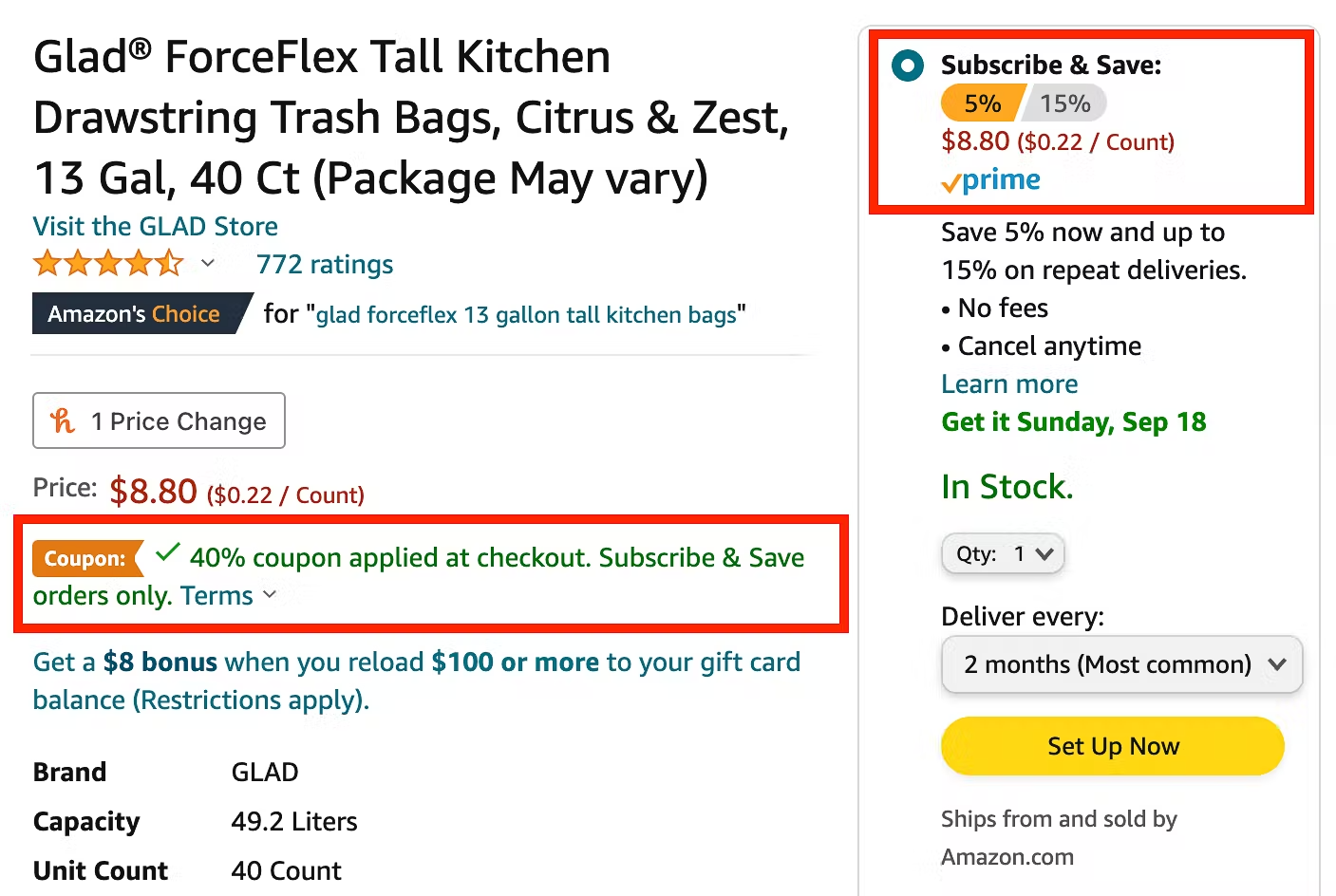
Jeff Bezos is quoted as saying
“[I]n our retail business, we know that customers want low prices, and I know that’s going to be true 10 years from now.”
He knows that part of customer satisfaction is having the lowest price available.
So, sure it’s a basic move, but we are surprised how many times this simple tool gets overlooked.
Amazon Coupons and Promotions are a great way to incentivize customers to purchase your products during launches (or relaunching after running out of inventory). Coupons and promotions are highly visible to customers on the product detail page, search results, and other parts of the Amazon website.
Generally, sellers see an average increase in sales of 60% during the week they run a promotion.
Amazon Marketing Strategy 12: Create an Amazon advertising strategy

Amazon PPC can be an effective way to drive traffic and sales. By using product display ads targeting specific keywords, you can reach customers who are actively searching for products like yours. By targeting other products you can create affinity and competitor campaigns to expand your reach even further than mere keywords. Additionally, Amazon PPC allows you to control your advertising costs, as you only pay when someone clicks on your ad.
If you’d like to dive deep into advertising on Amazon, check out Sean Farrington’s epic post: Amazon PPC Ads For Brands
Amazon Marketing Services
Multiple types of sponsored product ads are available to sellers via Amazon’s Marketing Services (AMS). These advertisements are linked to Amazon’s Seller Central portal (on Amazon marketing).
If you would like to dive deep into Amazon Marketing Services, check out this post: Marketing Services Amazon: Is AMS really the Key to Your E-Commerce Success?
Amazon Marketing Services uses keywords, categories, and products to target a specific audience for brands on Amazon. It’s extremely effective and should be a key component to any Amazon marketing plan.
AMS offers three distinct advertising programs: Product Sponsored Ads, Brand Sponsored Ads and Amazon DSP.
Amazon advertising in the UK, Australia, Canada, and USA
As Amazon continues to expand its reach globally, markets beyond USA and UK begin to emerge as promising marketplaces for online sellers looking to start or grow their FBA business.
In fact, in certain markets such as Australia, Amazon will overtake competitors as the number-one online retailer within a year or two.
Because of its rapid advancement, Amazon has the potential to reach the most diverse audience in the world. If you want to start international advertising, log onto your SellerCentral account, find international markets, and start a campaign in these markets.
Expand Off Of Amazon With Amazon DSP
Amazon provides its customers with access to Amazon exclusive market data. Amazon has enormous data about its consumer base and a vast database of customers. The purchase of the DSP platform gives you an overview and allows you to create customized sponsored product ads that target a different audience and different buying intent. How can I find out who has already purchased the product? Amazon generates a “lookalike” audience based on your existing audience.
For a deep dive into these types of ads check out our post: DSP Advertising (Amazon’s Secret Weapon): Insights From An Amazon Ad Agency
Bonus Marketing Strategy: Test and Learn
Testing and learning is a crucial aspect of building a successful Amazon sales channel. Consider testing everything you can:
Product Tiles (via Brand Registry A/B testing only)
Main Images (via Brand Registry A/B testing)
Image Stacks
Bullets
A+ content (via Brand Registry A/B testing)
Ad Campaign strategies (such as category and affinity campaigns)
By testing multiple elements and strategies, you can learn what works and what doesn’t. This can help you optimize your business and increase sales over time.
Conclusion
Amazon has a storied history of intentionally building and adjusting Amazon to become the marketplace monolith that it is today. Likewise, brands can take their cue from the 12 strategies that Amazon used and adapt them to use Amazon as a growing sales channel. Among these strategies are finding your own passionate brand story, building and protecting your brand, using tools to harvest data to your advantage, as well as testing and learning to optimize your Amazon assets over time. By following these strategies, you can increase your chances of making your Amazon business wildly successful.
FAQ:
Q: How can Amazon Coupons and Promotions help me increase sales?
A: Amazon Coupons and Promotions can help you increase sales by incentivizing customers to purchase your products. These promotions are visible to customers on various parts of the Amazon website, which can increase the visibility of your products.
Q: How important are customer reviews?
A: Customer reviews are crucial for building trust with potential customers and can significantly impact a product’s sales.
Q: How many reviews do I need to be successful on Amazon?
A: There’s no magic number, but having at least 20 reviews can help establish credibility and boost sales (and lower ad spend). However, the quality of the reviews is just as important as the quantity.
Q: Can I offer incentives for customers to leave a review?
A: Yes, you can offer incentives such as discounts or small rewards for leaving a review. However, be sure to disclose this in your review request and make it clear that the review should be honest and unbiased.
Q: Why is competitor tracking important on Amazon?
A: Competitor tracking is important on Amazon because it allows you to stay ahead of the game and identify areas where you can differentiate yourself and to draft keywords that are currently profitable. By monitoring your competitors’ activity, you can optimize your own pricing strategies, product listings, PPC efficiency, and marketing efforts to stay competitive.
Q: What is the most important factor for increasing Amazon sales?
A: There is no single factor that guarantees success on Amazon. To increase sales, you need to focus on multiple factors, including PPC advertising, search engine optimization, catalog management, and design.
Q: Why are testing and learning important for building a successful Amazon business?
A: Testing and learning allows sellers to optimize their sales by understanding what works and what doesn’t.


